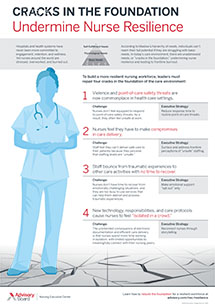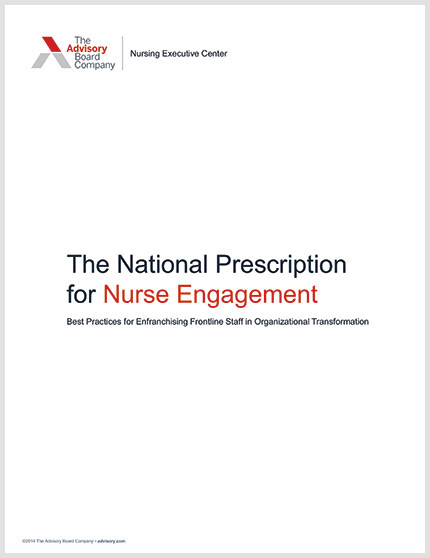Auto logout in seconds.
Continue LogoutRead Advisory Board's take: Why is it so hard to measure the impact of staffing ratios?
A new study suggests Massachusetts' mandatory limit on patient-to-nurse staffing ratios had little to no effect on ICU staffing or patient outcomes, but the Massachusetts Nurses Association, which is backing a ballot initiative to apply similar limits in other hospital departments, says the study does not offer a complete picture of the changes' effect.
Background: Massachusetts requires minimum level of nursing staff in ICUs
In 2014, Massachusetts passed a law intended to improve patient safety by regulating patient-to-nurse staffing ratios for ICUs. The regulation requires a 1:1 or 2:1 patient-to-nurse staffing ratio, depending upon patient acuity and anticipated care intensity.
Massachusetts voters next month will be asked whether the state should establish similar patient-to-staff ratios in other hospital departments, including operating rooms and labor and delivery units. The ballot initiative was submitted by the Massachusetts Nurses Association, and it has faced significant pushback from hospital groups and some smaller nursing groups, Boston Business Journal reports.
Study finds 2014 mandate had little effect on staffing, patient outcomes
For the study, which was published in the journal Critical Care Medicine, researchers at Beth Israel Deaconess Medical Center (BIDMC) compared the health outcomes of Massachusetts ICU patients to patients in out-of-state ICUs that were not subject to nurse staffing regulations to determine differences in staffing ratios and patient outcomes.
To do so, they examined data from 114 out-of-state academic medical center ICUs and six Massachusetts academic medical center ICUs. The researchers also analyzed admissions records from 246 medical centers in the United States.
The researchers found that the number of patients assigned to each nurse in Massachusetts ICUs decreased from 1.38 patients per nurse to 1.28 patients per nurse after the mandate. However, they observed similar trends in out-of-state ICUs that were not subject to state nurse staffing regulations. Further, they found that rates of patient morality and complications did not change after the mandate and were comparable to the rates of out-of-state ICUs.
The findings surprised the team, according to Anica Law, lead author of the study and a physician at BIDMC. "We hypothesized that Massachusetts ICU nurse staffing regulations would result in decreased complications and mortality for critically ill patients when compared with patients admitted to ICUs across the country unaffected by Massachusetts regulations," Law explained.
"Our results suggest that the Massachusetts nursing regulations were not associated with changes in staffing or patient outcomes," Law added. "The modest changes in nurse staffing we saw in Massachusetts—approximately one extra nurse per 20-bed ICU per 12-hour shift—remained unassociated with changes in hospital mortality."
MNA pushes back against study's results
According to the Boston Business Journal, the results suggest the changes sought by the ballot initiative may be unnecessary. However, David Schildmeier, a spokesperson for the MNA, said the study results do not paint an accurate picture of the 2014 mandate's effect because it only captures one year of data. According to the Business Journal, while the law was passed in 2014, the effective date was not until March 2016 for academic medical centers and January 2017 for community hospitals.
Schildmeier said, "We've had a limited time where the law has been fully implemented," adding, "To look at it and say it didn't succeed, it's too early to tell."
Schildmeier also explained that most ICU nurses, even before the mandate, only saw two patients at a time, which would explain why the regulation resulted in "modest changes." By contrast, Schildmeier said, a similar regulation would have a "more drastic effect" in other hospital departments, such as in surgical units, where some nurses have six or more patients, Bartlett reports.
"The ballot initiative deals with all the other units where [there] are no limits, where there is data that shows Massachusetts patients are more likely to suffer a readmission for heart failure than patients in California (which has nurse to patient limits), more likely to suffer readmissions for pneumonia than in California," Schildmeier said (Gooch, Becker's Hospital Review, 9/5; Bartlett, Boston Business Journal, 9/5; Mitchell, BIDMC release, 9/4).
Advisory Board's take

Katherine Virkstis, Managing Director, Nursing Executive Center
“The complete staffing picture involves multiple variables”
The results of this study are certainly interesting and could play a role in future legislative decisions. However, it's also worth putting them into context.
One of the reasons it's so difficult to measure the effectiveness of staffing legislation is that these mandates typically only consider a single staffing variable, such nurse to patient ratios. But the complete staffing picture involves multiple variables, such as:
- Nurse workload;
- Education;
- Specialty certifications;
- Experience; and
- The number of support staff.
Altering one of these variables almost always involves trade-offs. In other words, investing in one aspect of a care team often requires scaling back in another. For example, when leaders are required to increase the ratio of nurses to patients, they may need to reduce the number of support staff in order maintain a consistent labor budget. Think of it like squeezing a balloon—when you squeeze one side, the other side will expand.
Therefore, it's not just enough to think about overall staffing ratios when thinking about how nurse staffing may impact patient care. To make more informed staffing decisions, leaders need to understand how changes to one staffing variable impact other elements of the care team.
We can help. Our Nursing Executive Center has assembled a database for 360-Degree Nurse Benchmarking which contains multiple staffing variables for more than 2,600 acute care hospital units and ambulatory sites. These benchmarks provide nurse leaders with a unique dataset quantifying the trade-offs among staffing variables (including all of those above) within the same type of unit or ambulatory site.
Upcoming webconference: How Legacy Health innovated their nurse staffing model
Join nursing leaders from Legacy Health on Tuesday, October 23 at 1 pm ET to learn how they innovated their staffing model and designed a cross-system float nurse pool.
Don't miss out on the latest Advisory Board insights
Create your free account to access 1 resource, including the latest research and webinars.
Want access without creating an account?
You have 1 free members-only resource remaining this month.
1 free members-only resources remaining
1 free members-only resources remaining
You've reached your limit of free insights
Become a member to access all of Advisory Board's resources, events, and experts
Never miss out on the latest innovative health care content tailored to you.
Benefits include:
You've reached your limit of free insights
Become a member to access all of Advisory Board's resources, events, and experts
Never miss out on the latest innovative health care content tailored to you.
Benefits include:
This content is available through your Curated Research partnership with Advisory Board. Click on ‘view this resource’ to read the full piece
Email ask@advisory.com to learn more
Click on ‘Become a Member’ to learn about the benefits of a Full-Access partnership with Advisory Board
Never miss out on the latest innovative health care content tailored to you.
Benefits Include:
This is for members only. Learn more.
Click on ‘Become a Member’ to learn about the benefits of a Full-Access partnership with Advisory Board
Never miss out on the latest innovative health care content tailored to you.


